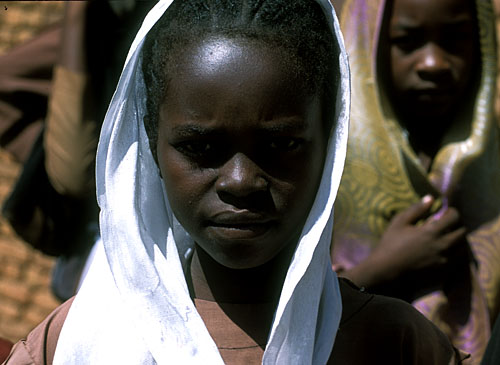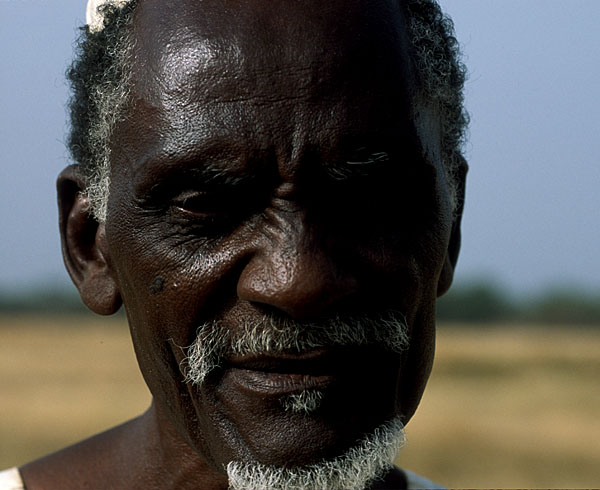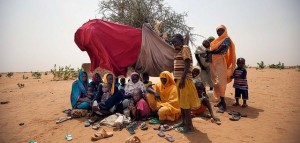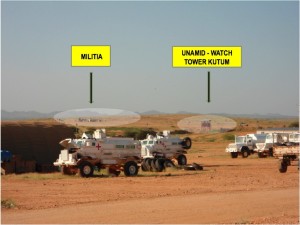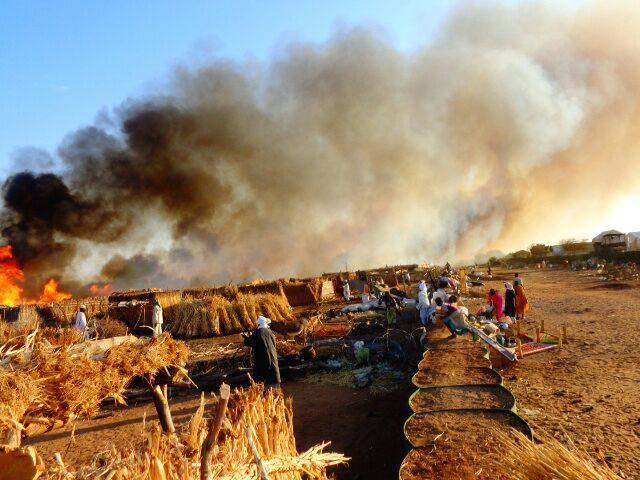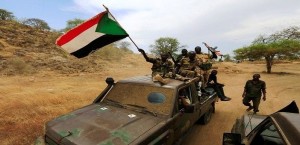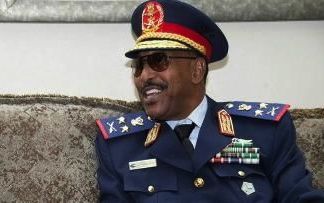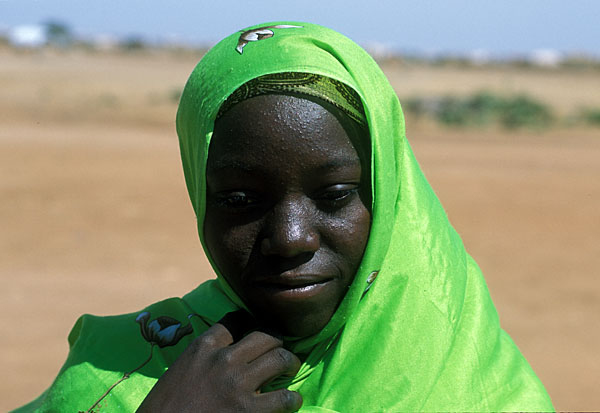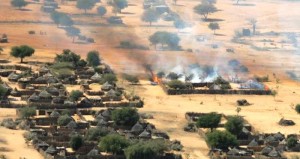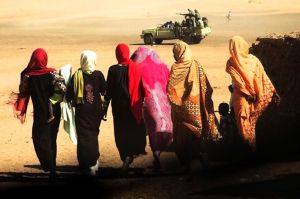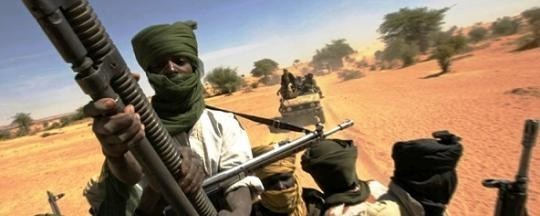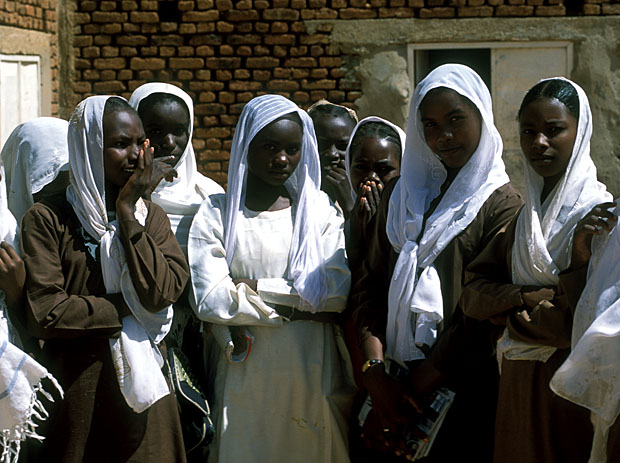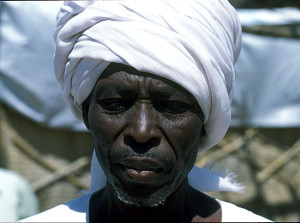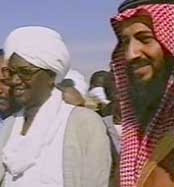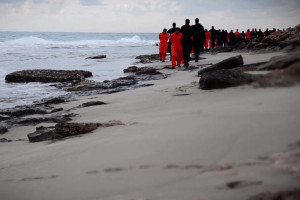This is the fourth installment of a digest containing what I believe to be the most important stories reported by Radio Dabanga in the previous week. Radio Dabanga has been by far our most important and reliable source of information about what is occurring in Darfur, and provides a great deal more than the UN/African Union Mission in Darfur (UNAMID), the UN Office for the Coordination of Humanitarian Affairs, and the largely worthless quarterly reports of the UN Secretary-General. I explain the reasons for this in prefaces to previous digests, along with examples of egregious omissions in the representation of Darfur, particularly around issues of rape, mortality, morbidity and malnutrition, and aerial attacks on civilians and civilian targets.
One of Khartoum’s targets ion Darfur
As I have repeatedly argued, it seems to me unconscionable that such important information is ignored, in part because it is not sufficiently disseminated. This, then, is the fourth in what will be weekly digests attempting to highlight the most important and broadly significant of Radio Dabanga’s most recent dispatches; I am currently limiting the number to ten, selecting from the past week only what seemed to me most important or representative of conditions on the ground in Darfur (closely related stories from the last week appear in subsidiary position in the text and with much less in the way of editorial commentary); thus the present digest goes back only to March 16, 2015, and is still perforce highly selective. Most dispatches have been edited to some degree for length; any editorial comments on my part appear italicized in [brackets]; all emphases within the texts have been added.
Two additional notes:
I continue to refer to “Central Darfur” as “formerly part of West Darfur,” which in fact it was. “Central Darfur”—whose creation was s political contrivance on Khartoum’s part—makes geographical comprehension and references considerably more difficult, has no historical justification, and renders in some ways obsolete our most important cartographic resource, the Darfur Field Atlases assembled by the UN Office for the Coordination of Humanitarian Affairs after the beginning of violence in 2003. The Atlases exist in three “volumes”: West Darfur, North Darfur, South Darfur | http://wp.me/p45rOG-1kv.
The first two dispatches by Radio Dabanga this week are particularly important and received disproportionately greater commentary: [1] on the UN assessment of conditions in Darfur and the future of UNAMID, and [2] a new effort by Khartoum to justify forced returns of displaced persons, specifically in West Darfur.
A displaced person who has likely lost his land, if not his family and village
Eric Reeves, 22 March 2015
Darfur: Radio Dabanga Digest, Number 1 | http://wp.me/p45rOG-1CD
Darfur: Radio Dabanga Digest, Number 2 | http://wp.me/p45rOG-1De
Darfur: Radio Dabanga Digest, Number 3 | http://wp.me/p45rOG-1Dt
Darfur: Radio Dabanga Digest, Number 4 | http://wp.me/p45rOG-1Ei and below
*********************************
March 18, 2015 | New York
The security and humanitarian situations in Darfur “deteriorated significantly” during the past year, according to Hervé Ladsous, UN Under-Secretary-General for Peacekeeping Operations. Speaking to the Security Council in his quarterly briefing on Tuesday, he said there has also been no tangible progress toward resolving the conflict. Ladsous presented two reports to the Council; the Secretary-General’s report on UNAMID, which covers work from 26 November 2014 to 12 February 2015, and a special report on the Mission’s three new strategic priorities [We might well wonder why these “new priorities”—if they are more than rhetorical posturing—were not implemented earlier: UNAMID took up its mandate of civilian protection I January 2008], whose implementation, Ladsous said, was the primary goal.
“The current upsurge in Darfur, at least for now, is largely attributable to the ongoing Government of Sudan and the Rapid Support Forces military offensive,” he stated.
Describing the government’s “dry season” military offensive against non-signatory armed groups, the UN peacekeeping official said that the government forces have significantly weakened and isolated the rebel groups geographically, while also causing “significant loss of lives and large-scale displacement.”
Around 450,000 people in total were newly displaced during 2014 [the final figure was closer to 500,000], as a result of violence, which, he said, was at a higher volume in any single year since the peak of the conflict in 2004. At least 300,000 of those remain displaced, mostly in camps. According to the UN peacekeeping official, the current number of displaced in Darfur totals 2.5 million…. [In fact, if we consider the almost 400,000 Darfuri refugees in eastern Chad, as well as refugees in other countries and the many displaced persons in Darfur who have not been registered by the UN, the number of Darfuris forced from their homes likely exceeds 3 million.]
Some of the 3 million people who have been forced from their homes by violence, including into eastern Chad and other countries; they are at acute risk from both violence and deprivation
Ladsous considers the prospects for holding the National Dialogue between the Sudanese government and the opposition before the general election begins on 13 April, “limited, with talks on Darfur breaking down and the government implementing measures curtailing political freedom.” He pointed in this context to the Berlin Declaration, signed on 27 February by the allied opposition forces, who called for the convening of an inclusive preparatory meeting at the AU headquarters in Addis Ababa to revive the talks. “The Berlin Declaration seems to demonstrate a certain consensus among the opposition to reengage in the National Dialogue,” he noted. [But the “opposition” has never engaged with the regime’s “National Dialogue,” recognized in its present form as nothing more than an electoral ploy, a political contrivance to legitimize the elections and their inevitable outcome—something that has been clear since the leaking of the minutes for the 31 August 2015 meeting of senior security and military officials in Khartoum. Per usual, Ladsous is deeply disingenuous in his use of the word “reengage.”]
Turning to the UN-AU peacekeeping Mission in Darfur, Ladsous described the efforts taken to address the three main challenges to its mandate implementation, which were identified in last year’s strategic review: improved cooperation with the government in some areas, implementation of measures to improve the Mission’s troops’ operational capabilities and effectiveness on the ground, and improvements to coordination and management structures. [Give the abysmal morale among UNAMID forces, the continuing—often very quiet—drawdown of these forces, and the deep mistrust of the Mission by Darfuris, there are merely the words of a UN bureaucracy looking for something to say in the face of massive and incontrovertible failure.] “Nevertheless, some of the major challenges remain,” he said, listing the need to improve UNAMID’s reporting of incidents and analysis, its internal and external communications approach, and the recruitment of personnel to key posts. “Despite strategic and operational-level improvements in coordination with the UN Country Team [Ladsous offers no meaningful evidence of these “improvements,”] further progress on establishing an effective Darfur-wide early warning and response system is required.”
This is the force in which Ladsous claims to see “improvement” (photograph from Radio Dabanga (18 August 2014 | https://www.radiodabanga.org/node/78745 : “Government-backed militiamen shooting at civilians near a UNAMID team site. One was killed, and eight injured. UNAMID did not intervene, and the attack was reported by the UN as a ‘cross-fire incident’ (UNAMID).”
[Ladsous is proposing all this at the same time he and the UN Department of Peacekeeping Operations are actively planning, with Khartoum, an “exit strategy” for the Mission, whose Security Council authorization expires in June—and will not be renewed, certainly not in anything like its present form. Khartoum will insist that all agreements, including the Status Forces Agreement (SOFA, February 2008), must be re-negotiated; and these new agreements, whatever they are, will mean nothing to Khartoum, which has massively and systematically violated the SOFA from the earliest days of UNAMID’s deployment.
[Finally, Ladsous’ assessment would have us believe that the escalation of violence in Darfur is a product of the “past year.” This is deeply, disgracefully false, and clearly designed for self-exculpation. In 2012 Ladsous began the drawdown of UNAMID, declaring that improved security conditions on the ground permitted this; he specifically cited the border region between West Darfur and eastern Chad. We know, however, that violence has escalated significantly throughout the past three years (see Appendix A for analyses of violence that was clearly accelerating throughout 2012). Moreover, we should recall that since 2012 well over 1 million people have been newly displaced, and as has long been the case, violence and displacement are highly correlated in Darfur.
[The view of Darfur from Khartoum is radically at odds with Ladsous’ attenuated and self-serving account of security in Darfur (from the same Radio Dabanga dispatch):
“Situation in Darfur is stable”
In a reaction to the statements of the UN Under-Secretary-General for Peacekeeping Operations, Ambassador Hassan Hamid Hassan, UN Permanent Representative of Sudan, told reporters…that Ladsous’ statements about Darfur were “quite contradicting, as the current situation in the five states of Darfur is stable.”
Governor Hassan’s vision of “stability” in West Darfur–here a burning camp for displaced persons
[Such shameless mendacity is never directly challenged by UN officials, even when it is transparent.] As for the exit of UNAMID from Darfur, [Hassan] said that the “Security Council is now seriously considering an exit strategy.” [As suggested by the following dispatch, Khartoum also has a very different sort of “exit strategy” in mind for the people of Darfur:
March 22, 2015 | El Geneina
The Sudanese government plans to dismantle the camps for the displaced in West Darfur, according to the Governor.
Governor Haidar Galokuma told the Sudanese Centre for Press Services, owned by the security apparatus, on Thursday that his government intends to dismantle the camps in West Darfur, as part of its plans to return the displaced to their villages of origin. The West Darfur camps for the displaced are not needed anymore, he explained, as “an unprecedented secure and stable situation is prevailing in the state.”
Sheikhs in the camps described Galokuma’s statements as “lies and deceptive,” referring to recent attacks on displaced at the Azirni, Kongok, Kereinik, and Um Tajuk camps.
The New Janjaweed, the Rapid Response Forces, have been active in West Darfur, particularly in the Kereinik area
[The desire to empty and dismantle the camps for displaced persons has been central to Khartoum’s strategy for over a decade. It was first articulated in 2004 by then Interior Minister Abdel Rahim Mohamed Hussein—now Defense Minister and indicted for massive crimes against humanity in Darfur by the International Criminal Court for actions during his term as Interior Minister. As the history of Darfur becomes increasingly obscured, outrageous mendacity such as this on the part of Hussein are being forgotten. From the UN IRIN:
[Abdel Rahim Mohamed Hussein, then Minister of the Interior and the regime’s special representative on Darfur, announced on Sudanese government-controlled radio on July 9, 2004] “that 86 percent of the Internally Displaced Persons had already returned to their villages” (UN Integrated Regional Information Networks, 12 July 2004). [Hussein further declared that] “it was ‘most important’ to get people to return to their villages. Each state the Darfur region has three—had its own plan of return.” (UN Integrated Regional Information Networks, 12 July 2004).
Indicted for massive crimes against humanity by the International Criminal Court, Defense Minister and former Interior Minister Abdel Rahim Mohamed Hussein is still a powerful voice in the regime. His efforts to accelerate returns of displaced persons are an appropriate measure of his brutality and mendacity.
[West Darfur Governor Galokuma is simply issuing Khartoum’s latest justification for the forced returns of displaced persons. For they will be forced: the overwhelming majority of the 2.5 million in camps are not there by choice but because insecurity is intolerable in and around their villages and lands—villages that have, in many thousands of cases, been comprehensively destroyed, and lands that have been seized by Arab nomadic groups and militia forces as forage areas for their livestock.
[In 2004 voices in the humanitarian community, including from the UN, immediately voiced opposition to such returns; it seems increasingly doubtful that such voices will be heard in the present. But the danger of such forced returns is even greater now; and with the withering of UNAMID, its timetable for expiration of its current authorization (June 2015), and the uncontrolled violence that dominates Darfur, especially in North Darfur, these returns will become—for an incalculable number of people—a death sentence unless the international community pressures Khartoum to cease.]
March 19, 2015 | Mellit Locality
In an attack by a joint force of paramilitary Border Guards and Central Reserve Police (Abu Tira) on Maksi village in Mellit locality, on Tuesday, nine people were killed. “A large group of Border Guard and Abu Tira troops in 24 Land Cruisers, mounted with Dushka [heavy] machineguns raided the village. They plundered the shops, and torched a number of houses. Nine people were killed, including a woman,” a villager who fled reported to Radio Dabanga. He said that Maksi village was attacked before, on 27 February, whereby four people were killed, and four others were injured. The paramilitary forces seized ten villagers, accusing them of being rebels and took them to El Fasher, the state capital of North Darfur. They were later released, after having been severely beaten and tortured. [It is hard not to see such attacks as evidence of precisely the “security vacuum” Under-Secretary -General Ladsous and his working group would have us see as a potential threat only in the future.]
People such as this young woman will continue to be raped and killed until there is a meaning protection force on the ground in Darfur. This is not part of Ladsous’ plan.
March 20, 2015 | Kereinik, West Darfur
Militiamen supported by the government have threatened to burn down a camp for displaced people in Kereinik locality in West Darfur if the residents do not pay them a large sum of money. A witness explained that a border guards leader and several members claimed that residents of camp Um Tojok killed his son in 1986, for which they now demand blood money, totalling SDG 115,000 ($19,370). The son of leader Azirig Kody had stolen cows in the camp at the time, and was allegedly killed by a rescue team the residents had assembled, the witness said. The people have informed the State Deputy-Governor Abu El Gasim Baraka about the threats by the border guards. According to the witness, he has not intervened to resolve the problems yet. The inaction prompted one of the traders in the area to pay SDG 26,000 ($4,380) in advance. The camp residents received an ultimatum to pay the remaining blood money to the guards before Saturday.
[Such extortion schemes, along with road checkpoint shakedowns, theft and plunder have become increasingly frequent as security continues to deteriorate. Arson, and the threats of arson, continue to plague many camps, and it is often impossible to determine whether fires were accidental or deliberately set, either as part of extortion schemes or the regime’s general policy of dismantling the camps—see above. The attack on Kereinik hardly seems evidence for what Governor Galokuma speaks of as “the unprecedented secure and stable situation prevailing in (West Darfur)”]
Few Darfuris take threats of arson without the utmost seriousness—and fear
One dead, two injured in new fire at Bindisi camp, [formerly West] Darfur
March 16, 2015 | Bindisi
A Koran student died and two others sustained burns at the Bindisi camp for the displaced in [formerly West] Darfur on Sunday. “Since three weeks, fires are breaking out in the camp for reasons unknown,” a camp sheikh reported to Radio Dabanga. “Between 2 and 3pm on Sunday, a fire that started at the camp’s Koran school, led to the death of one student, and the injury of two others. The blaze spread quickly to the adjacent shelters, and destroyed about 50 homes,” he said. “We were unable to distinguish it well, because of the lack of water in the camp.” The sheikh explained that the fires have destroyed more than 300 shelters until now. “The displaced are extremely worried. About 70 people left and sought refuge in other camps. “Many are convinced that the fires are caused by arson. They accuse the authorities of deliberately setting the fires, in order to dismantle the camps….”
Once underway, fires in camps are extremely difficult to bring under control, given the nature of the building materials and the close proximity of dwelling.
March 16, 2015 | Jebel Marra
The entire population of 13 villages near Golo in western Jebel Marra, [formerly West] Darfur, who fled attacks by government forces last January, are living in an extremely dire humanitarian situation. “More than 11,000 people sought refuge in the area of Bouri, about 1km west of Golo,” one of the villagers informed Radio Dabanga. “We are living in caves and under trees, with little water and food. The people are trying to survive on what they find in the neighbourhood. Most of the children have diarrhoea, and measles is spreading rapidly, while we do not have access to any form of health care.” [Jebel Marra is certainly an area where we don’t need to speak about a “security vacuum” in the future tense. Displacement in the region, especially eastern Jebel Marra, has been massive, and violence against villages extreme in all ways and completely uncontrolled].
The challenges and dangers of displacement have been consistently underestimated and understated by many in the international community, including the UN, U.S., EU, and AU
Women, child gunned-down in Darfur’s East Jebel Marra
March 19, 2015 | Mashrou Abu Zeid
Multiple witnesses told Radio Dabanga that a group of paramilitary Rapid Support Forces in five armed Land Cruisers stormed Wadi Ashara, north of Mashrou Abu Zeid, this morning, and started stealing livestock. “When some women protested, they fired at them. [Five people] were killed instantly,” a source reported. “17 cows and eight donkeys also died in the shooting.” The witnesses reported that the militiamen stole 270 head of cattle in total. They added that the attackers were part of a force of RSF militia troops in 35 armed vehicles that had arrived near the valley.
The men who kill defenseless women and children: members of the Rapid Support Forces in North Darfur
Villagers robbed, beaten in Darfur’s Jebel Marra
March 19, 2015 | Golo / Kabkabiya
A group of army and militia troops assaulted a number of people near Golo in western Jebel Marra, [formerly West] Darfur, on Tuesday. One of them is reported missing. In Kabkabiya, North Darfur, militiamen shot a villager, and took his belongings Speaking to Radio Dabanga, a one of the victims reported that they were attacked by the government forces “just a half a kilometre northeast of Golo.” “They beat us with their rifle butts, before they robbed us of our money, mobiles, and all our other belongings,” he said.
Two young women gang-raped in East Jebel Marra
March 21, 2015 | East Jebel Marra (North Darfur)
Five members of the paramilitary Rapid Support Force gang raped two young women in East Jebel Marra on Friday. A relative of one of the victims told Radio Dabanga that five RSF militiamen intercepted the two women at 8am, after they had left the village of Tourada, 15km east of Fanga, to collect firewood. “They raped the two alternately at gunpoint, and did not release them until noon,” he said.
Targets for rape
Five dead, three injured in Darfur shootings
March 17, 2015 | Darfur
Five people were killed and three others were wounded in South Darfur, [formerly West] Darfur, and East Jebel Marra on Sunday and Monday. In Dumma, north of South Darfur’s capital of Nyala, farmer Adam Suleiman Ahmed Adam was shot dead by militiamen on Sunday evening. A tribal sheikh told Radio Dabanga that members of a government militia opened fire at Adam. “He and his donkey died instantly. [Such murders, occurring all over Darfur, make nonsense of Ladsous implicit claim that there is not a “security vacuum” at present.]
Ordinary, noncombatant Darfuris are increasingly targets for rape and murderous assaults; the claim by UN Under-Secretary General for Peacekeeping Operations Hervé Ladsous that a “security vacuum” is something that lies in Darfur’s future is an obscene misrepresentation of tense. The lack of insecurity is felt everywhere, by civilians and humanitarians alike.
March 18, 2015 | Zamzam Camp
The residents of Zamzam camp for the displaced [one of the largest in Darfur, and the camp to which many have fled recently], near El Fasher, capital of North Darfur, are suffering from a severe drinking water crisis. “People are queuing in long lines, from the early morning onwards. The lines are that long that after waiting for 24 hours, they still have not obtained a tin of water,” a Zamzam camp sheikh reported to Radio Dabanga. He explained that the lack of water sources and the increase in the number of displaced have exacerbated the problem. “In particular the newly displaced have difficulties in accessing drinking water. They live far away from water sources, and have to walk for 3 kilometres to reach a water source, and then walk back the same distance carrying the water tins on their heads,” he added. [There continue to be critical shortages of clean water, or indeed any water, in many camps—and the water tables are drawn ever lower, even as more displaced persons arrive.]
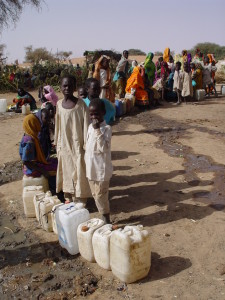 Waits for water can seem interminable
Waits for water can seem interminable
March 17, 2015 | El Fasher Locality
Residents of El Salam camp for the displaced in Kabkabiya locality, North Darfur, staged a demonstration on Monday, in protest against the reduction of humanitarian assistance. Speaking to Radio Dabanga, El Salam camp sheikh Mutawakil Mohamed Bashir said that officers of the Sudanese Humanitarian Aid Commission and the UN World Food Programme (WFP) had informed them that morning that only the vulnerable displaced would receive aid. “They told us that after an inventory of the needs of the camp residents, it will be decided who will continue to receive food rations, and who not. Other relief services would be reduced too. “We responded by telling them frankly that all displaced at the camp are vulnerable. All of them, without exception, are in need of assistance, as they lost all their belongings. They are also not able to search for work because of the rampant insecurity in the region.”
[Food shortages continue to grow, the UN’s World Food Program finds transport and implementing partners for distribution increasingly difficult to find—and as bread shortages accelerate (see below), there will be more incentive for food bound for Darfur to be diverted for sale along the way from Port Sudan. It appears that the WFP is cooperating with Khartoum in forcing returns of displaced persons by denying them food.]
March 18, 2015 | Khartoum
The production of bread in Sudan has been downsized because of a lack of flour. Badreldin El Jalal, Secretary-General of the National Flour Chamber, attributed the bread crisis to the reduction of flour distribution by Saiga Company, one of the largest flour companies in Sudan, to its agents in the states. He denied rumours that the government intends to monopolise the flour trade. The Ministry of Finance announced arrangements to control the distribution of wheat and flour to the states, to ensure that the bakeries will be able to continue producing bread. In particular people in eastern Sudan’s Port Sudan, and Berber locality in the northern River Nile state, are suffering from the flour crisis. In Berber, people are lining up in front of the bakeries to obtain their daily bread since five days, Salah El Jumeili, Director of Trade and Cooperation in Berber locality told the press. He also attributed the crisis to Saiga’s reduction of the flour rations. The country witnessed a similar flour crisis at the end of last year, because of the scarcity of foreign currency needed for the import of wheat.
[Despite the myopic assessment by Crisis Group (“Though the threat of economic and political crisis has eased [in Sudan]…” 11 March 2015) the political crisis remains explosive; and even more significantly for the long-term stability of Sudan, the economic crisis continues to grow more acute. Little has changed since my broader assessment of the economy this past September. The Bureau of Central Statistics manufactures figures of convenience, but this does nothing to represent or change economic realities.]
March 21, 2015 | Mellit
At least 28 people were killed and injured in an attack by [Arab] Ziyadiya tribesmen on Mellit town, North Darfur, on Thursday. Speaking to Radio Dabanga, multiple witnesses reported from the town that the attack was triggered by an attack on a vehicle on the Mellit-El Fasher road. In the ensuing firefight, a Ziyadiya member of the Central Reserve Police (Abu Tira) was shot dead, and four others sustained bullet wounds. In response, a group of Ziyadiya militiamen in 11 armed vehicles attacked the southeastern districts of Mellit in the late afternoon. 13 [non-Arab] Berti were killed and six Ziyadiya tribesmen. At least ten people sustained injuries. Three houses were destroyed by fire.
The sources all reported that the situation in the area is extremely tense, and appealed to the Sudanese government to “immediately intervene to contain the situation.”
[Longstanding tensions between the Arab Ziyadiya and the non-Arab Berti have become especially acute, indeed violent, largely because of a wish by various parties, preeminently the Khartoum regime, to control territory near the Jebel ‘Amer gold mines (see below). There is growing evidence that notorious Janjaweed leader Musa Hilal (of the Mahameed Arab tribal group) is involved in conflict related to Jebel ‘Amer, which is in the territory of the Beni Hussein, het another Arab group.]
Dozens die in North Darfur’s Jebel ‘Amer
March 16, 2015 | Jebel ‘Amer
Dozens of people died recently, owing to the spread of various diseases in the gold mining area of Jebel ‘Amer, El Sareif Beni Hussein locality in North Darfur…. According to the source, the deteriorating health environment resulting from the overcrowding of workers in the mines has caused the rapid spread of the diseases.
Fever and smuggling in North Darfur gold mines
March 20, 2015 | El Fasher
The North Darfur government confirmed the emergence of diseases and fevers in the state’s mining areas, in particular Jebel ‘Amer, as well as a number of foreigners who smuggle large quantities out of the country. Ahmed Mohamed Sadig El Karori, North Darfur Minister of Minerals, acknowledged the two problems during a meeting with the state government in El Fasher. He claimed that the ministry’s aim is to control the mining in North Darfur, especially in Jebel ‘Amer, El Sareif Beni Hussein locality. The governor also pointed out that the presence of foreigners from West African countries in the mining areas has led to smuggling. The gold workers are contracted in the mines without the involvement of the state. The smuggled quantities are larger than those entering the markets [according to the governor].
[Smuggling is precisely what Khartoum wishes to avoid: gold is meant to go into the Central Bank of Sudan, serving as a means of bolstering depleted foreign exchange reserves, the absence of which makes importing goods and services impossible—thus the shortages of wheat, which is ground into flour and made into bread, a staple food in the lives of many Sudanese.]
March 20, 2015 | Khartoum
Eleven students and one doctor of a government-owned medical university in Khartoum have left Sudan to join the extremist IS in Iraq and Syria. In the past two weeks, they initially set out for Turkey to work with medical teams that treat civilians injured during the war waged by the international coalition against the extremist Islamic State (IS). According to local media in Sudan on Thursday, the University of Medical Sciences in Khartoum reported that the twelve left with British passports for Turkey. Their families fear that they will join the IS after receiving the news of their departure from Turkey by telephone….
Osama bin Laden in Sudan (mid 1990s) with Islamist ideologue Hassan al-Turabi—still on the political scene in Khartoum
Another source in the university acknowledged that an association called “Islamic Civilisation” is active within the university, to stimulate students to join the extremists. But he was unsure “whether the association has a relationship with extremist organisations outside the university.” Political activities inside the university are stopped. However, the Islamic Civilisation manages to operate there without intervention, and has put up posters advertising their case. Its members wear djellaba, short robes, inside the university. The women students wear burqa and are veiled. Most students in the faculty come from wealthy Sudanese families that live in Arab countries….
In 2013, a student of the University of Medical Sciences left to Mali, to fight in the ranks of Islamic extremist groups. Islamic extremist groups in Sudan operate through religious associations in mosques, while being covered by the Islam-orientated Sudanese government.
[None of this should be surprising, given the revelations about the Khartoum regime’s relation to the world of radical Islam, Jihadists, and actual terrorist groups [see minutes of 31 August 2015 meeting of senior military and security officials in Khartoum, in which this relation—particularly with Iran—is discussed at length and detail | http://wp.me/p45rOG-1wk.]
The Khartoum regime boasts of its support for radical Islam in Libya, specifically the Libya Dawn movement; here is a recent photograph of what “radical Islam” in Libya can mean: 21 Coptic Christian from Egypt being led to their beheadings.
****************************
Appendix A: Large-scale violence in Darfur began to accelerate dramatically throughout 2012, as consistently reported by Radio Dabanga, as well as by extremely well-placed and highly reliable sources in the field; the evidence was ignored by the UN, most conspicuously by UN Under-Secretary-General for Peacekeeping Operations Hervé Ladsous. His assessment of 25 April 2012 should be read in the context of the violence chronicled below:
U.N. Peacekeeping Chief Hervé Ladsous is recommending that the organization drawdown its U.N.-African Union peacekeeping force in the Darfur region of Sudan by more than 4,000 troops and police in the coming months. Ladsous said Thursday that improvements on the ground [in Darfur] justify the move. (Voice of America, 25 April 2012 | http://www.voanews.com/articleprintview/370489.html)
On accelerating violence in Darfur, 2012:
• Human Security in Darfur, Year’s End 2012: North Darfur, 17 January 2013. An assessment of the most violent region of Darfur since July 2012 (Part 3 of 3), including the grim first weeks of 2013 | http://wp.me/s45rOG-3736
• Human Security in Darfur, Year’s End 2012: South Darfur, 11 January 2013. Intolerable human insecurity and threats to humanitarian operations in Darfur remain largely invisible; an overview in three parts: South Darfur (Part 2); Sudan Tribune | http://www.sudantribune.com/spip.php?article45158
• Human Security in Darfur, Year’s End 2012: West Darfur, 27 December 2012. Intolerable human insecurity and threats to humanitarian operations in Darfur remain largely invisible | http://wp.me/p45rOG-Xy
• Growing Violence in Darfur Deserves Honesty Reporting, Not More Flatulent UN Nonsense, 12 December 2012 | http://wp.me/p45rOG-Wv
• Violence in Hashaba, North Darfur: A brutal portent, another UN disgrace, 30 October 2012 | http://wp.me/p45rOG-UR
• The Avalanche of Violence Continues to Accelerate in Darfur, 11 October 2012 | http://wp.me/p45rOG-U1. International responses range from superficial to non-existent, a powerful signal to Khartoum about the consequences of its ongoing war against civilians.
• Darfur: UN Failure and Mendacity Culminate in an Avalanche of Violence, 12 August 2012 | http://www.sudanreeves.org/?p=3376
• Darfur Moves Yet Deeper into the Shadow of Lies, 22 July 2012 | http://www.sudanreeves.org/?p=3344
• Darfur and Kadugli (South Kordofan): Obduracy Rewarded, Sudan Tribune, 8 April 2012 | http://wp.me/p45rOG-MO
• RAPE AS A CONTINUING WEAPON OF WAR IN DARFUR: Reports, bibliography of studies, a compendium of incidents, 4 March 2012 | http://wp.me/p45rOG-Kw
Significantly extended at | http://wp.me/p45rOG-KC
• The Seen and the Unseen in Darfur: Recent reporting on violence, insecurity, and resettlement, 2 March 2012 | http://wp.me/p45rOG-Ki
• “Passive in the Face of Sudan’s Atrocities,” The Washington Post, 9 February 2012 | http://www.washingtonpost.com/opinions/washingtons-passive-response-to-sudans-atrocities/2012/01/31/gIQA4qhW2Q_story.html
• [Excerpt] Former Members of the UN Panel of Experts for Darfur Offer a Damning Alternative to the “Official” Report, 17 April 2012 | http://wp.me/p45rOG-Nk
We now have side-by-side reports on Darfur—one from the present, politically hand-picked UN team and the other from three distinguished former members of the panel who felt obliged to resign because the UN would not allow them to do their job in appropriately professional fashion, with appropriately professional colleagues. Africa Confidential broke the story last week (13 April 2012), and provides important insights into the larger implications of the marked contrasts in substance and authority between the two reports (links at the end of the AC dispatch).
Following the Africa Confidential dispatch, I offer here the first part of a detailed account of the discrepancies between the two reports, and what these discrepancies suggest of UN performance in Darfur, particularly that of UNAMID. It should be recalled that the senior UNAMID official for West Darfur, Dysane Dorani, figured prominently in a February 26, 2012 dispatch from The New York Times, declaring rapturously: “It’s amazing. The people are coming together. It reminds me of Lebanon after the civil war.”
But on the basis of its reading of the two reports, Africa Confidential reaches a conclusion precisely the opposite of that offered by the Times correspondent in Nyuru, who found in this one location “a sign that one of the world’s most infamous conflicts may have decisively cooled” (emphasis added):
“[The report by the previous, professionally qualified experts] argues that the Darfur crisis, far from winding down as Khartoum and some press reports suggest, is worsening, with new incidents of ethnic cleansing, arms deliveries and aerial bombing.”
2014 Timeline:
Darfur in 2014: A nightmare impossible to “slumber” through, 30 December 2014:
PART ONE: http://wp.me/p45rOG-1y6
PART TWO: http://wp.me/p45rOG-1y3
*******************************
“The victims [of the Holocaust] perished not only because of the killers, but also because of the apathy of the bystanders. What astonished us after the torment, after the tempest, was not that so many killers killed so many victims, but that so few cared about us at all.”
[Elie Wiesel, “Why were there so few?”]
